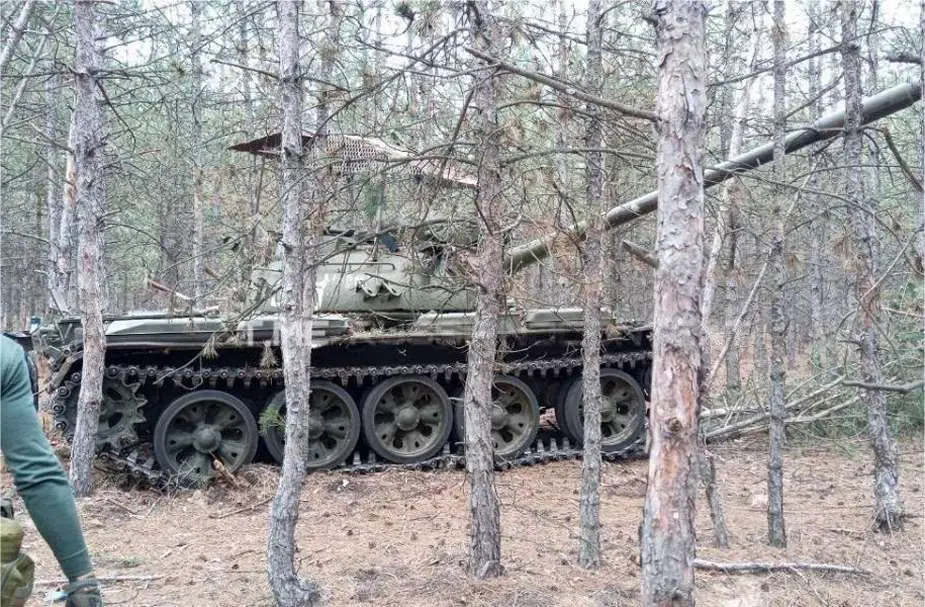According to a post on the Russian social network VK, the use of old T-55 tanks by Russian forces has been observed in Ukraine. These relics from the Soviet era, although technologically outdated, are playing the role of self-propelled artillery in the theater of war. This tank is being used to potentially compensate for the large number of Russian armored vehicle losses announced by the Ukrainian forces.
Follow Army Recognition on Google News at this link

Rather than being deployed as a traditional combat tank, the T-55 is employed as a 100 mm self-propelled gun (Picture source: Russian social media)
The T-55, first introduced in the 1950s, was one of the main battle tanks of the Soviet Union. Its robust design and reliability have been proven on numerous battlefields. However, with the advent of advanced technologies and new weapon systems, the T-55 has been largely replaced or upgraded in many countries.
In Ukraine, these tanks are used unconventionally. Rather than being deployed as a traditional combat tank, the T-55 is employed as a 100 mm self-propelled gun. Operating from closed positions, they provide indirect fire support, similar to artillery, rather than a direct offensive role on the battlefield.
The continued use of the T-55 raises questions about strategic choices and logistical capabilities. This decision might reflect a shortage of more modern equipment or a deliberate strategy to conserve more advanced resources for other aspects of the conflict. It may also indicate a pragmatic approach, exploiting available resources for specific roles. It's a way to compensate for the material losses suffered in Ukraine, as the production of new material, although increased, does not yet compensate for all the losses on the front. A simple (but not necessarily effective) way is to empty the stocks of old material.
The T-55 is normally a main battle tank that has been adopted by over 70 countries worldwide. The main armament of the T-55 is a 100 mm gun, complemented by two 7.62 mm SGMT machine guns and a 12.7 mm DShKM machine gun for self-defense. This combination of weapons offers the T-55 an offensive capability, but it's outdated compared to Western vehicles present among the Ukrainian forces.
In terms of protection, the T-55 is designed to withstand small arms fire and shell splinters, with a maximum armor of 100 mm at the front and 80 mm on the sides of the hull. Although modest compared to modern standards, this armor gives it sufficient resilience against various threats on the battlefield. The operational capabilities of the T-55 are enhanced by various accessories such as an infrared night vision system, an NBC (nuclear, biological, chemical) protection system, and day/night vision devices. The T-55 has a maximum range of 500 km, extendable to 650 km with additional fuel tanks. The Russian tank can also reach a maximum speed of 50 km/h on roads and 27 km/h off-road.
Finally, the T-55 is designed for a crew of four people, which differs from modern Russian tanks that benefit from an automatic reloading system that reduces the crew from four to three men. Its dimensions include a total length of 9 meters with the gun facing forward, a hull length of 6.2 meters, a width of 3.64 meters, and a height of 2.35 meters, giving it a relatively compact silhouette for a tank of this category.
When comparing its statistics with more modern equipment like the German Leopard 2A4 or the M1A1 Abrams, there is no match. The T-55 is completely outclassed by the equipment available to the Ukrainians, hence its use as a self-propelled artillery piece is more than pertinent. However, the T-55 is not without strengths; it is exceptionally reliable and can start in any condition. Moreover, this model was produced in astronomical quantities following Soviet doctrines. The wide availability of spare parts is then a significant advantage in the high-intensity war currently being waged in Ukraine.
It is noted that the T-55 we can see have not been sent directly to the front but have undergone upgrades. Thus, we can observe protective cages intended to defend the tanks against possible UAV attacks. We can hope that other improvements have been made to compensate for its technological backwardness, but nothing is less certain.
The presence of the T-55 on the Ukrainian battlefields is an example of solutions implemented by Russia to compensate for the number of armored vehicles lost in Ukraine. The effectiveness of such an old system remains to be proven; however, its reliability and large numbers may compensate for this technological delay.















